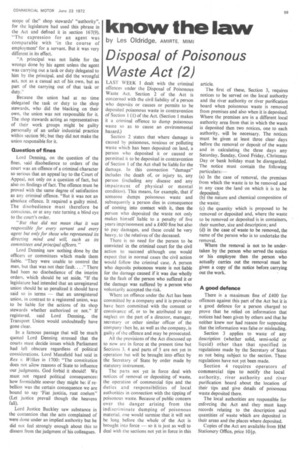know the law
Page 59

If you've noticed an error in this article please click here to report it so we can fix it.
by Les Oldridge AMIRTE MIMI
Disposal of Poisonous Waste Act (2)
LAST WEEK I dealt with the criminal offences under the Disposal of Poisonous Waste Act. Section 2 of the Act is concerned with the civil liability of a person who deposits or causes or permits to be deposited poisonous waste in contravention of Section 1(1) of the Act. (Section 1 makes it a criminal offence to dump poisonous waste so as to cause an environmental hazard.) Section 2 states that where damage is caused by poisonous, noxious or polluting waste which has been deposited on land, a person who deposited it or caused or permitted it to be deposited in contravention of Section 1 of the Act shall be liable for the damage. In this connection "damage" includes the death of, or injury to, any person (including any disease and any impairment of physical or mental condition). This means, for example, that if someone dumps poisonous waste and subsequently a person dies in consequence of coming into contact with it, then the person who deposited the waste not only makes himself liable to a penalty of five years imprisonment and a £400 fine but also to pay damages, and these could be very heavy, to the relatives of the deceased.
There is no need for the person to be convicted in the criminal court for the civil action to succeed although one would expect that in normal cases the civil action would follow the criminal case. A person who deposits poisonous waste is not liable for the damage caused if it was due wholly to the fault of the person who suffered it or the damage was suffered by a person who voluntarily accepted the risk.
Where an offence under the Act has been committed by a company and it is proved to have been committed with the consent or connivance of, or to be attributed to any neglect on the part of a director, manager, secretary or other similar officer of• the company then he, as well as the company, is guilty of the offence and may be prosecuted.
All the provisions of the Act discussed up to now are in force at the present time but Sections 3, 4 and parts of 5 are not yet in operation but will be brought into effect by the Secretary of State by order made by statutory instrument.
The parts not yet in force deal with notices of removal or depositing of waste, the operation of commercial tips and the duties and responsibilities of local authorities in connection with the tipping of poisonous waste. Because of public concern over the danger arising from the indiscriminate dumping of poisonous material, one would surmise that it will not be long before the whole of the Act is brought into force — so it is just as well to deal with the sections not yet in force in this article.
The first of these, Section 3, requires notices to be served on the local authority and the river authority or river purification board when poisonous waste is removed from premises and also when it is deposited. Where the premises are in a different local authority area from that in which the waste is deposited then two notices, one to each authority, will be necessary. The notices must be given at least three clear days before the removal or deposit of the waste and in calculating the three days any Saturday, Sunday, Good Friday, Christmas Day or bank holiday must be disregarded. The notice must contain the following particulars:—
(a) In the case of removal, the premises from which the waste is to be removed and in any case the land on which it is to be deposited; (b) the nature and chemical composition of the waste; (c) the quantity which is proposed to be removed or deposited and, where the waste to be removed or deposited is in containers, their number, size and description; and (d) in the case of waste to be removed, the name of the person who is to undertake the removal.
Where the removal is not to be undertaken by the person who served the notice or his employee then the person who actually carries out the removal must be given a copy of the notice before carrying out the work.
A good defence
There is a maximum fine of £400 for. offences against this part of the Act but it is a good defence for a person charged to prove that he relied on information that notices had been given by others and that he neither knew nor had reason for supposing that the information was false or misleading.
Section 3 applies to waste of any description (whether solid, semi-solid or liquid) other than that specified in regulations made by the Secretary of State as not being subject to the section. These regulations have not yet been made.
Section 4 requires operators of commercial tips to notify the local authority, river authority and river purification board about the location of their tips and give details of poisonous waste deposited there.
The local authorities are responsible for enforcing the Act and they must keep records relating to the description and quantities of waste which are deposited in their areas and the places where deposited.
Copies of the Act are available from HM Stationery Office, price 10+p.












































































































